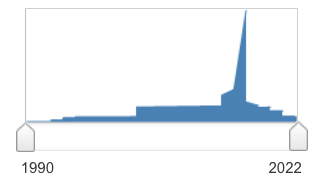
May 7, 2021, by Brigitte Nerlich
Genetically modified mosquitoes and creatively unmodified metaphors
Last week genetically modified (GM) mosquitoes were released in Florida. One news item reported the event as follows: “The British company Oxitec released a cloud of hundreds of millions of genetically modified mosquitoes to study how to control their reproduction and thus stop the spread of dengue, Zika, malaria, etc.” (Entrepreneur, 4 May, 2021).
What type of genetic modification are we dealing with? “According to the company, the males in their insect cloud have a modified gene, called OX5034, that restricts the survival of the females they mate with. Thus, mosquitoes will not grow large enough to bite humans (only females consume blood; males feed on nectar).”
This is NOT ‘gene drive’, another way of trying to manage vector borne diseases, but one that has not been tested in the wild yet. By contrast, GM mosquitoes have been released before in Brazil and the Cayman Islands, not without arousing debate. A very good overview of the controversies surrounding these experiments, including discussions of issues relating to public engagement can be found in this article in the Bulletin of the Atomic Scientists entitled “Paradise altered”, a nice metaphor (if it is a metaphor)!
I became interested in all this after Sarah Hartley tweeted some other articles, with headlines containing metaphors and clichés, such as gene hacking, playing God, and Jurassic Park (here and here, for example). And I thought ‘there we go, the old metaphors fly again’. Hadn’t I seen them before in press coverage of GM food, stem cells, synthetic biology, gene editing, and, of course, gene drive? Do we suffer from, what José van Dijck called back in 1999, a deficit in genetic imagination?
Mozzie metaphors over time
I wanted to see what other metaphors may be used in the context of GM mosquitoes and dipped into the news database Lexis Nexis (but much much more research is needed here!). After putting in the search phrase ‘GM mosquitoes’, I found around 1000 articles, the earliest dating back to the turn of the millennium, followed by a steep peak around 2015/2016. That was the time I became interested in this topic and even published a parody of the Frankenflies trope.
I couldn’t check all the articles of course, but on the whole, the coverage has been, it seems, quite sedate, apart from at its peak around 2015/2016 when Zika swept the world and when Oxitec’s OX513A, which had been approved by Brazil in 2014, was used to try to combat the Zika in Piracicaba, São Paulo in 2016. At that time quite a few Frankenclichés were flying about, as well as many war metaphors. Then things calmed down and metaphors faded away again.
That changed recently, as the headlines noticed by Sarah indicate. To these one should add this one in The Sun :“BUZZ OFF! Swarm of MILLIONS of gene-hacked mosquitoes will be unleashed across USA – to wipe out malaria with ‘death sex’” (8 June, 2020) – one laughs, but it’s actually not a laughing matter. We also found such sex-language in gene drive coverage, even in broadsheets. And, of course, the word ‘buzz’ was used copiously throughout press coverage of GM mosquitoes in particular.
Early mozzie musings
The surprise for me was that GM mosquitoes were already discussed around 2001 in various guises and without too many fearful metaphors. On the contrary, there was, for a short period, an atmosphere of hope, which however ebbed away for various reasons in around 2003/2004. Again, this needs more research! I should also say that Oxitec was not really on the scene then, as it was only just founded in 2002.
James Meek, then science editor for The Guardian wrote an article in 2001 entitled “Scientists plan to wipe out malaria with GM mosquitoes” and said: “scientists have found two ingenious ways to drive a non-advantageous gene through mosquito populations so that eventually all mosquitoes inherit it” – note the word ‘drive’, not yet ‘gene drive’, but ‘drive’ nevertheless. Two years later, in 2003 Oliver Morton wrote about ‘gene drive’ for the popular science magazine New Scientist in an article called “Splat!”. Back to 2001 and James Meek.
What were these two ingenious ways to deal with mosquito populations? They were the use of the bacterium Wolbachia (now used quite routinely it seems to deal with the spread of malaria) and the use of what Meek calls a ‘freakish’ “chunk of DNA called a transposable element, which hops between chromosomes during reproduction” – what would become, I think, gene drive proper (transposons, also known as ‘jumping genes’, represent an example of a natural gene drive – nowadays, thanks to gene editing, we have synthetic ones, but not yet used in the wild).
In this early coverage of GM mosquitoes, there was some talk of super mosquitoes and designer mozzies, but nothing about playing God, and nothing about Jurassic Park, as far as I can see. These and other metaphors and clichés began to creep in after 2010 or so. In 2009 one also finds a headline on Oxitec mosquitoes using the ubiquitous war metaphor: “Mosquito Wars” (News Press, 20 April, 2009), a phrase also used by the World Health Organisation and in an academic article!
Mozzies and responsibility
Interestingly, already at the turn of the millennium the future members of the gene drive community were reported to reflect on ethical issues! The Edinburgh Evening News reported in 2001 that “Scientists working on changing the genetic make-up of the species first reported their work earlier this year. The London conference will debate the benefits and ethics of the issue.” Such debates would continue at regular intervals and become more global and more scrutinised.
In 2009 the article entitled “Mosquito Wars” reported that “In recognition of WHO’s role in providing guidance, a technical consultation will be held in May in Geneva to assess the current status and discuss future plans for developing GM mosquitoes as a control tool. Co-organized with the Foundation for the National Institutes of Health, the consultation will bring together experts in global biotechnology, safety and GM research, as well as regulatory and policy officials from WHO Member States. ‘The meeting will cover issues such as biosafety assessment, regulatory, ethics and the social aspects of research,’ explains Touré. The technical consultation will be followed by a broader public consultation that will be attended by nongovernmental organizations and advocacy groups, as well as media representatives.”
Such meetings would continue and later include novel issues around wider ‘gene drive’ governance, a topic at the heart of Sarah Hartley’s research (here on RRI and GM mosquitoes in Brazil; here on knowledge engagement and gene drive, for example).
Missing mozzie metaphors
Overall then, GM mosquitoes have been buzzing through the media since around the year 2000 (and I certainly couldn’t catch them all), generating hopes and fears. They provoked efforts to created new frameworks for responsible governance, but did not really inspire new metaphors. That would not change even with he advent of gene drive, where the same metaphors would be trotted out again, against a backdrop of increasing interest in responsibility, transparency and openness. Is that because we lack imagination or is that because we are grappling with old issues, such as control over science and technology? Who has it? Who should have it? What happens if we lose it? Would that matter, and to whom?
In the context of genetic modification and genetic engineering, the modern myth of Frankenstein, now finely dissected in all its complexity in chapter 2 of Philipp Ball’s great new book The Modern Myths: Adventures in the Machinery of the Popular Imagination, will be with us for a while yet, together with the old ones of the Sorcerer’s apprentice and Pandora’s Box.
Image: Gene drive mosquitoes, Image credit: Genome Research Limited
Previous Post
How the pandemic is shaping worldviewsNext Post
The coronavirus: A global metaphorNo comments yet, fill out a comment to be the first


Leave a Reply